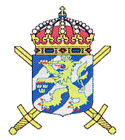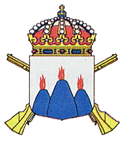

Copyright © Hans Högman 2019-05-20
Swedish Regiments of
the Allotment System -
Infantry (3)
Infantry Regiments:
1. Swedish Regiments -
Infantry (3)

Swedish name: Älvsborgs
regemente, I15
The regiment was first established in
1624 as the Älvsborg Regiment. The
regiment was linked to the Allotment
System in 1683.
In 1949 the regiment was reorganized into an
armored infantry regiment. In 1963 the regiment
once again was reorganized and this time back to a
regular infantry regiment.
The regiment's history goes back to the "fänikor" that
was raised in the provinces of Västergötland and
Dalsland around 1552. In the 1613, King Gustav II
Adolf formed a "landsregemente" - a Grand
Regiment, from the Västergötland fänikor and from
the fänikor in the province of Dalsland. The Grand
Regiment numbered 3000 soldiers.
In 1624 the Grand Regiment was split up into three
independent regiments, The Skaraborg Regiment,
The Älvsborg Regiment and the Västgöta-Dal
Regiment.
As a result of the Constitution adopted in 1634 the
Army was reorganized. The Älvsborg Regiment was
then referred to as the "11th Regiment".
In 1624, when the regiment was established, the
provinces in the south and south west of Sweden
(Skåne, Blekinge, Halland and Bohuslän) belonged to
Denmark. The province of Västergötland (where the
Älvsborg Regiment was established) was then a
border province facing Denmark. The provinces of
Skåne, Blekinge, Halland and Bohuslän became
Swedish territory in 1658.
The regiment was allotted with 1200 "rotar".
Hence, the Regiment had 1200 soldiers organized
into 8 companies. All of the "rotar" were located
within the southern parts of province of
Västergötland.
Names of the Companies making up the
Regiment in 1682: The Life Company, The
Lieutenant Colonel's Company, The Major's company,
Södra Kinds Company, Norra Kinds Company,
Redwågs Company, Åhs Company and Giesenäs
Company.
Uniform before the standard uniform: Grey coat
with yellow cuffs (1677). The regiment received the
standard uniform (the blue and yellow Carolean
uniform) in1691.
Location of the primary Garrison of the
Regiment: From 1914, Borås. Training camp:
Between 1685 and 1770 Timmele hed, Ulricehamn,
between 1770 and 1783 Kila hed, Borås,
between1784 and 1796 Örby hed, Borås and from
1797 Fristad hed, Borås.
The Official Regimental Colors: Yellow and black
Companies 1854:
1.
Life Company
2.
Marks Company
3.
Södra Kinds Company
4.
Ås Company
5.
Vedens Company
6.
Norra Kinds Company
7.
Gäseneds Company
8.
Redvägs Company
Victorious Battle Campaigns (segernamn):
•
Leipzig
1642
•
Helsingborg
1710
•
Gadebusch
1712
Swedish name: Västgötadals
regemente, I16
The regiment was first established in
1624 as the Västgöta-Dal Regiment.
The regiment was linked to the
Allotment System in March 16 1685.
In 1902 the regiment moved to the province of
Halland and received the name the Halland
Regiment. The regiment was organized as a bicycle
infantry regiment between 1942 and 1952.
Before the Västgöta-Dal Regiment moved to the
province of Halland there were a battalion in Halland
called The Halland Infantry Battalion (I28). This
battalion was established in 1813. However this
battalion did not become a part of the new Halland
Regiment.
Instead, the Halland battalion merged with the
Värmland Rifle Corps (Värmlands fältjägarkår) in
1902 and formed the new regiment The Waxholm
Grenadier Regiment (Waxholms
grenadjärregemente, I26). In 1928 this regiment
became a part of the Göta Life Guards (Göta livgarde)
as this regiment's first battalion.
The regiment's history goes back to the "fänikor" that
was raised in the provinces of Västergötland and
Dalsland around 1552. In the 1613, King Gustav II
Adolf formed a "landsregemente" - a Grand
Regiment, from the Västergötland fänikor and from
the fänikor in the province of Dalsland. The Grand
Regiment numbered 3000 soldiers.
In 1624 the Grand Regiment was split up into three
independent regiments, The Skaraborg Regiment,
The Älvsborg Regiment and the Västgöta-Dal
Regiment.
As a result of the Constitution adopted in 1634 the
Army was reorganized. The Västgöta-Dal Regiment
was then referred to as the "12th Regiment".
The regiment was allotted with 1200 "rotar".
Hence, the Regiment had 1200 soldiers organized
into 8 companies. The regiment's "rotar" were
located within the provinces of Västergötland (600)
and Dalsland (600).
Names of the Companies making up the
Regiment in 1682: The Life Company, The
Lieutenant Colonel's Company, The Major's
Company, Sun and Nordals Company, Tössbo
Company, Kållands Company, Vedbo Company and
Kullings Company.
Uniform before the standard uniform: Grey coat
with yellow cuffs (1676). The regiment received the
standard uniform (the blue and yellow Carolean
uniform) in1691.
Location of the primary Garrison of the
Regiment: From 1907, Halmstad. Training camp:
Between 1685 and 1863 Nygårdsängen, Värnersborg,
from 1863 Grunnebro hed. In Halland: Skedala,
Halmstad
The Official Regimental Colors: Yellow and black
(The Halland Regiment: White and blue).
Companies 1854:
1.
Life Company
2.
Väne Company
3.
Kållands Company
4.
Kullings Company
5.
Valbo Company
6.
Vedbo Company
7.
Tössbo Company
8.
Sundals Company
Companies 1 - 4 formed the Life Battalion and
companies 4 - 8 the Dal Battalion.
Victorious Battle Campaigns (segernamn):
•
Lützen
1632
•
Leipzig
1642
•
Lund
1676
•
Gadebusch
1712
Swedish name: Västmanlands
regemente, I18
The regiment was first established in
1623 as the Västmanland Regiment.
The regiment was linked to the
Allotment System in 1682.
The regiment was disestablished in 1927. The
tradition of the regiment was then forwarded to the
Air Force, The Västmanland Wing (Västmanlands
flygflottilj). The Wing was disestablished in 1982.
It is unusual for an air wing to get the permission to
carry the Victorious Battle Campaigns of an infantry
regiment.
The regiment's history goes back to the "fänikor" that
was raised in the province of Västmanland in the
16th century. In 1617, King Gustav II Adolf formed a
"landsregemente" - a Grand Regiment, from the
Västmanland fänikor and from fänikor in the
provinces of Dalarna and Uppland.
In 1623 the Grand Regiment was split up into three
independent regiments, The Västmanland Regiment,
The Uppland Regiment and The Dalecarlia Regiment.
As a result of the Constitution adopted in 1634 the
Army was reorganized. The Västmanland Regiment
was then referred to as the "15th Regiment".
The regiment was allotted with 1200 rotar.
Hence, the Regiment had 1200 soldiers organized
into 8 companies. The regiment's "rotar" were
located within the counties of Västmanland (940),
Örebro (55) and Kopparberg (205).
Names of the Companies making up the
Regiment in 1682: The Life Company, The
Lieutenant Colonel's Company, The Major's
Company, Hundra härads Company, Rassbo
Company, Siggetuna Company, Lagunda Company
and Bälings Company.
Uniform before the standard uniform: Red coat
with yellow cuffs (1675). The regiment received the
standard uniform (the blue and yellow Carolean
uniform) in1691.
Location of the primary Garrison of the
Regiment: From 1906, Västerås. Training camp:
First Västerås and Utnäs löt , Strömsholm and from
1780 Salbohed, Sala.
The Official Regimental Colors: White and blue
Companies 1854:
1.
Life Company
2.
Folkare Company
3.
Väsby Company
4.
Salbergs Company
5.
Västerås Company
6.
Strömsholms Company
7.
Bergs Company
8.
Kungsörs Company
Victorious Battle Campaigns (segernamn):
•
Narva*
1700
•
Düna
1701
•
Kliszow*
1702
•
Fraustadt*
1706
•
Helsingborg
1710
•
Gadebusch
1712
•
Walkiala
1790
The battle names above marked with a "*" are the
Battle Campaigns the regiment carries in the
Regimental Colors. However, according to the Army
Colors Committee of 1892 the regiment also have
the right to carry the battle names without an "*".
Related Links
•
The Allotment System
•
Swedish Wars
•
The Navy & the Army Fleet
•
Swedish Military Unit Designations
•
Swedish Military Branch and Unit Insignias
•
Uniforms of the Swedish Army
•
Source References
Top of page
Infantry Regiments, page:
-1- -2- -3- -4- -5- -6- -7-




11. Älvsborg Regiment, I15
12. Västgötadal Regiment, I16
15. Västmanland Regiment, I18


























